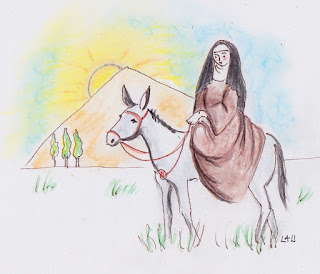When she was seven, the future Saint Teresa ran away with her brother to seek martyrdom among the Moors in Africa. An uncle found them outside the city walls of Avila and dragged them home. Later, as a Carmelite nun, she crisscrossed Spain on muleback, cleaning up corrupt convents, founding new ones, and doing battle against resistant clerics. And all the while she was writing masterpieces of literature that endure to this day, making friends with that other great mystic and writer, Saint John of the Cross, and having ecstatic visions of God.
Although she'd been dead for four centuries, Teresa's power radiated all the way through the chalk dust in our classrooms and the ink stains in our uniforms."She was a mystic, a writer, a reformer, a theologian, and a doctor of the Church," the teacher told us "even though she was ONLY A WOMAN!"
For us, Teresa was a no-nonsense saint, grown-up and bold, with none of the sickly prettiness of the little virgin martyrs (Lucy, Agnes, Margaret, Cecilia, etc.) whose main merit seemed to consist in their refusal to have sex. In the 1950s, a decade that revered domesticity, and in a culture where virginity, followed by marriage and motherhood, were practically the only options for women, Saint Teresa showed us a different picture of how to be a woman: brave, intelligent, determined, a leader of women and men.
If Teresa of Avila had been the only model held up for our admiration, all would have been well. But in counterpoint to the bold image of the saint we were offered a list of tamer, more "feminine" virtues: we were urged to be patient and humble, and to always think of others before ourselves. Unquestioning obedience was at the top of the list, as was the strictest chastity. "When you go to bed at night," I remember one of my German nuns advising us, "do not let your hands wander all over your body." (Years later, my college roommate said I was the only person she knew who fell asleep with her arms straight at her side, like a corpse in a casket.)
But it was that trio--humility, selflessness, and obedience--that was the most effective at quashing our girlish spirits. How could we nine- and ten-year-olds reconcile those ego-stifling virtues with the drive and assertiveness that Saint Teresa must have possessed in order to achieve all that she did?
It was a dilemma that we were too young to solve, and it caused us much confusion and uncertainty.
It was not altogether bad to have our vision of the indomitable aspects of Saint Teresa's character tempered with the milder virtues. But I shudder to imagine what life would have been like for us girls without the image of the great Saint fighting for justice, writing books, founding convents and monasteries. Years before we heard of Simone de Beauvoir, Betty Friedan, and Gloria Steinem we had Saint Teresa of Avila, in her sandals and brown habit, riding her mule in all weathers, showing us what a woman could be.
The Passage of Time
1 week ago


After being educated by fabulous Benedictine nuns in Mexico City, I briefly considered joining them, but my enthusiasm wilted on the rocks of the requirement of obedience. I knew I didn't have it in me, and even very successful religious had been told to shut up - and did - when an ignorant superior (or one who had different aims for them than success) told them to.
ReplyDeleteI'm sure sometimes it WAS merited or necessary, but I wasn't going to sign up for it - life in Mexico for women was bad enough.
I suppose it also provided freedom from the life of a wife and mother, but I couldn't see that part when I was 16 or so and made my mother move me to a different school because my classmates were not interested in the subjects I held dear.
I'm more obedient in some areas now that I understand them better, and far less in others where old white men still want to control my life.
So you had Benedictine nuns in your life too!
DeleteI wonder how strictly the obedience vow is viewed these post-Vatican II days.
OK. You've made me a fan.
ReplyDelete